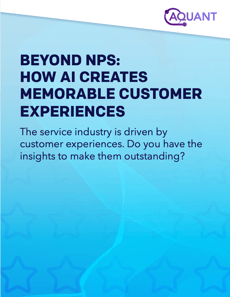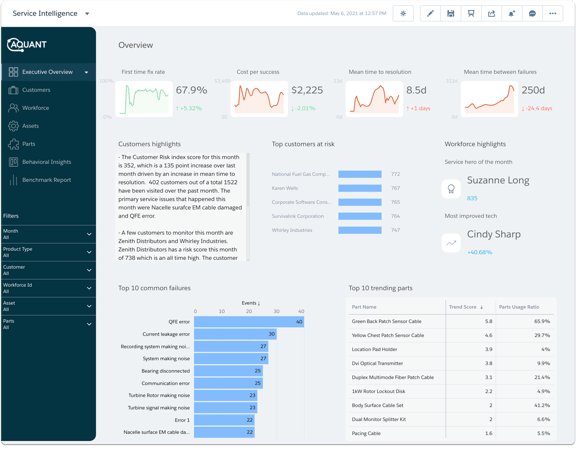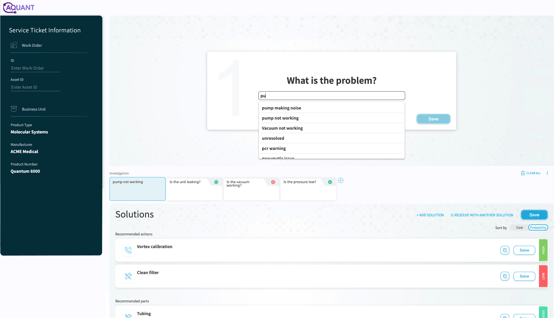In this second excerpt from a recent white paper published by Aquant, we discuss which methods are best for creating customer risk scorecards and managing workforce performance issues.
ARCHIVE FOR THE ‘features’ CATEGORY
Jul 22, 2021 • Features • Digital Transformation • Service Leadership • Aquant • customer experience
In this second excerpt from a recent white paper published by Aquant, we discuss which methods are best for creating customer risk scorecards and managing workforce performance issues.

This feature is just one short excerpt from a white paper published by Aquant
www.fieldservicenews.com subscribers can read the full white paper now by hitting the button below.
If you are yet to subscribe you can do so for free by hitting the button and registering for our complimentary subscription tier FSN Standard on a dedicated page that provides you instant access to this white paper PLUS you will also be able to access our monthly selection of premium resources as soo as you are registered.
 Data usage note: By accessing this content you consent to the contact details submitted when you registered as a subscriber to fieldservicenews.com to be shared with the listed sponsor of this premium content Aquant who may contact you for legitimate business reasons to discuss the content of this white paper, as per the terms and conditions of your subscription agreement which you opted into in line with GDPR regulations and is an ongoing condition of subscription.
Data usage note: By accessing this content you consent to the contact details submitted when you registered as a subscriber to fieldservicenews.com to be shared with the listed sponsor of this premium content Aquant who may contact you for legitimate business reasons to discuss the content of this white paper, as per the terms and conditions of your subscription agreement which you opted into in line with GDPR regulations and is an ongoing condition of subscription.
A host of analytical and business intelligence (BI) resources exist solely for keeping tabs on metrics.
But standard BI tools still have limitations.
For one, they don’t usually understand a large chunk of your free text service data, including details sourced directly from customer comments, call center agent notes, field technician debriefs, and machine log files. Standard BI tools make it challenging to access, analyze, or interpret unstructured data without a team of data scientists on standby.
Classic BI dashboards only display what’s currently happening within an organization based on past data, which is usually incomplete. The big picture remains obscured once again, making it difficult to use those insights to reach company goals and spot patterns that reveal likely future events. This can lead to the prioritization of unnecessary KPIs, or even worse, analysis paralysis.
Business leaders need total transparency and understanding of their current service landscape to succeed. And these can only be accomplished using tools that give you quick access to easy-to- read analyses that go beyond past trends, offering an idea of what is likely to happen in the future and providing prescriptive recommendations.
Leaders should be leveraging data-centric insights to create the most desired outcomes for their customers — ones that support growth and provide teams with the visibility and know-how to resolve any issues that arise.
Evaluating Performance With Standard KPIs Alone Creates Blind Spots
Most service organizations track KPIs, but too many narrowly focus on single measurements such as first time fix. Knowing the FTF rate is an important performance indicator, but when measured in a vacuum, it offers an incomplete or inaccurate snapshot of the health of your service organization.
Without zooming out for a 360-degree view, decisions that boost one KPI might lead to systemic and costly service issues. For example, how is team performance impacting customer satisfaction, or how are high first time fix rates driving up service costs?
It is beneficial to have a comprehensive understanding of service KPIs, including:
-
First time fix (FTF)
-
Mean time to resolution (MTTR)
-
Mean time between failure (MTBF)
By looking at these metrics in depth, you’ll gain deeper insight into every aspect of the service lifecycle, and see clear connections between performance and service outcomes.

This feature is just one short excerpt from a white paper published by Aquant.
www.fieldservicenews.com subscribers can read the full white paper now by hitting the button below.
If you are yet to subscribe you can do so for free by hitting the button and registering for our complimentary subscription tier FSN Standard on a dedicated page that provides you instant access to this white paper PLUS you will also be able to access our monthly selection of premium resources as soo as you are registered.
 Data usage note: By accessing this content you consent to the contact details submitted when you registered as a subscriber to fieldservicenews.com to be shared with the listed sponsor of this premium content Aquant who may contact you for legitimate business reasons to discuss the content of this white paper, as per the terms and conditions of your subscription agreement which you opted into in line with GDPR regulations and is an ongoing condition of subscription.
Data usage note: By accessing this content you consent to the contact details submitted when you registered as a subscriber to fieldservicenews.com to be shared with the listed sponsor of this premium content Aquant who may contact you for legitimate business reasons to discuss the content of this white paper, as per the terms and conditions of your subscription agreement which you opted into in line with GDPR regulations and is an ongoing condition of subscription.
Further Reading:
- Read more about Aquant on Field Service News @ www.fieldservicenews.com/aquant
- Read more about Digital Transformation @ www.fieldservicenews.com/digital-transformation
- Read more about Leadership & Strategy @ www.fieldservicenews.com//leadership-and-strategy
- Learn more about Aquant @ www.aquant.io
- Follow Aquant on Twitter @ twitter.com/Aquant_io
Jul 21, 2021 • Features • Aly Pinder • Covid-19 • Servitization and Advanced Services • GLOBAL
Kris Oldland, Editor-in-Chief, Field Service News is joined on the Field Service News Digital Symposium by Aly Pinder Jr, Program Director of Service Innovation and Connected Products at IDC. Aly is a seasoned expert in the field service industry,...
Kris Oldland, Editor-in-Chief, Field Service News is joined on the Field Service News Digital Symposium by Aly Pinder Jr, Program Director of Service Innovation and Connected Products at IDC. Aly is a seasoned expert in the field service industry, technology and innovation and he always thinks forward and spots the upcoming trends in the industry.
During the conversation, the two discuss a wide range of topics related to the evolution of service, the rapid changes and challenges that occurred during the last year and what organisation should do to adapt and prepare for the future.
In this final excerpt from that full interview, the discussion turns to whether the pandemic has slowed down the move to servitization for field service organizations.
Want to know more?
FSN Premium subscribers and FSN Elite members can access the full-length interview plus many, many more in the Field Service New Digital Symposium. If you have an FSN Premium account you can access the video on the button below. If you are currently on our FSN Standard subscription tier you can upgrade your subscription by clicking the link below.
If you are yet to subscribe you can join 30,0000 of your field service management peers by subscribing to FSN Standard for free to gain access to a monthly selection of premium content or select either FSN Premium or FSN Elite for even more resources. Click the button above to visit our subscription page to find out more.
Further Reading:
- Read more about Servitization & Advanced Services @ www.fieldservicenews.com/servitization
- Read more about the impact of COVID-19 in the Field Service industry @ www.fieldservicenews.com/covid-19
- Read exclusive articles by Aly Pinder on Field Service News @ www.fieldservicenews.com/aly+pinder
- Follow Aly Pinder on Twitter @ twitter.com/Pinderjr
- Connect with Aly Pinder on LinkedIn @ linkedin.com/in/aly-pinder-jr
Jul 20, 2021 • Features • Digital Transformation • Workforce Managemnet • Field Workforce • EMEA
Kris Oldland, Editor-in-Chief, Field Service News is joined by Mark Belenky, CEO Software Outsourcing Solutions and a specialist in workforce management solutions to work through some of the key findings of an exclusive Field Service News Research...
Kris Oldland, Editor-in-Chief, Field Service News is joined by Mark Belenky, CEO Software Outsourcing Solutions and a specialist in workforce management solutions to work through some of the key findings of an exclusive Field Service News Research project that spoke to over 100 service leaders from the field service sector and beyond to understand the key trends in workforce management.
During the discussion, the two discuss a number of key insights revealed from the data including the key metrics that define workforce management success, how companies are optimising the costs of managing the workforce and what tools and processes are being used for best-in-class workforce management.
In this excerpt from that full interview, the two analyse whether service-centric organisations are placing too much emphasis on placement and not enough effort on employee engagement.
Want to know more?
FSN Premium subscribers and FSN Elite members can access the full-length interview plus many, many more in the Field Service New Digital Symposium. If you have an FSN Premium account you can access the video on the button below. If you are currently on our FSN Standard subscription tier you can upgrade your subscription by clicking the link below.
If you are yet to subscribe you can join 30,0000 of your field service management peers by subscribing to FSN Standard for free to gain access to a monthly selection of premium content or select either FSN Premium or FSN Elite for even more resources. Click the button above to visit our subscription page to find out more.
Further Reading:
- Read more about Digital Transformation @ www.fieldservicenews.com/digital-transformation
- Read more about Workforce Management @ www.fieldservicenews.com/workforce-management
- Learn more about Software Outsourcing Solutions @ www.s-o-services.com
- Connect with Mark Belenky on LinkedIn @ linkedin.com/in/markbelenky
Jul 16, 2021 • Features • Digital Transformation • Workforce Managemnet • Field Workforce • Managing the Mobile Workforce • EMEA
Kris Oldland, Editor-in-Chief, Field Service News is joined by Mark Belenky, CEO Software Outsourcing Solutions and a specialist in workforce management solutions to work through some of the key findings of an exclusive Field Service News Research...
Kris Oldland, Editor-in-Chief, Field Service News is joined by Mark Belenky, CEO Software Outsourcing Solutions and a specialist in workforce management solutions to work through some of the key findings of an exclusive Field Service News Research project that spoke to over 100 service leaders from the field service sector and beyond to understand the key trends in workforce management.
During the discussion, the two discuss a number of key insights revealed from the data including the key metrics that define workforce management success, how companies are optimising the costs of managing the workforce and what tools and processes are being used for best-in-class workforce management.
In this excerpt from that full interview, the conversation focuses on the industry data revealing that, for service-centric companies, the biggest issue regarding workforce management is overwhemingly staff utilization.
Want to know more?
FSN Premium subscribers and FSN Elite members can access the full-length interview plus many, many more in the Field Service New Digital Symposium. If you have an FSN Premium account you can access the video on the button below. If you are currently on our FSN Standard subscription tier you can upgrade your subscription by clicking the link below.
If you are yet to subscribe you can join 30,0000 of your field service management peers by subscribing to FSN Standard for free to gain access to a monthly selection of premium content or select either FSN Premium or FSN Elite for even more resources. Click the button above to visit our subscription page to find out more.
Further Reading:
- Read more about Manage the Mobile Workforce @www.fieldservicenews.com/managing-the-mobile-workforce
- Read more about Workforce Management @ www.fieldservicenews.com/workforce-management
- Learn more about Software Outsourcing Solutions @ www.s-o-services.com
- Connect with Mark Belenky on LinkedIn @ linkedin.com/in/markbelenky
Jul 15, 2021 • Features • Digital Transformation • Aquant • Covid-19 • customer experience
In the first article of a series of excerpts from a recent white paper published by Aquant, we look at the importance of providing exceptional customer experience in the post-pandemic world.
In the first article of a series of excerpts from a recent white paper published by Aquant, we look at the importance of providing exceptional customer experience in the post-pandemic world.

This feature is just one short excerpt from a white paper published by Aquant
www.fieldservicenews.com subscribers can read the full white paper now by hitting the button below.
If you are yet to subscribe you can do so for free by hitting the button and registering for our complimentary subscription tier FSN Standard on a dedicated page that provides you instant access to this white paper PLUS you will also be able to access our monthly selection of premium resources as soo as you are registered.
 Data usage note: By accessing this content you consent to the contact details submitted when you registered as a subscriber to fieldservicenews.com to be shared with the listed sponsor of this premium content Aquant who may contact you for legitimate business reasons to discuss the content of this white paper, as per the terms and conditions of your subscription agreement which you opted into in line with GDPR regulations and is an ongoing condition of subscription.
Data usage note: By accessing this content you consent to the contact details submitted when you registered as a subscriber to fieldservicenews.com to be shared with the listed sponsor of this premium content Aquant who may contact you for legitimate business reasons to discuss the content of this white paper, as per the terms and conditions of your subscription agreement which you opted into in line with GDPR regulations and is an ongoing condition of subscription.
The acceleration of digital technologies in every sector from grocery delivery to banking created customer expectations that are higher than ever. And there’s every indication that it will remain this way.
Customers want effortless service interactions. To win hearts and wallets, you have to provide interactions that go beyond “good.” Every interaction should feel personalized while also aiming to wow. For service organizations, the expectation is that you’ve joined all the dots before a service ticket is placed.
For many organizations who are already in the midst of transformation projects, the question is how to pivot technology adoption and service delivery to achieve those goals. For some, Net Promoter Score (NPS) has been the best way to do that. They monitor loyalty and metrics and give companies intel on how users feel about services — but in the current landscape, where time is money, there are a few drawbacks. Often, the feedback is too ambiguous, arrives too late, and lacks full context, rendering companies powerless to change outcomes.
NPS can’t tell you why a customer left a particular rating, doesn’t explain why clients are loyal, and doesn’t provide guidance on how to improve your services. When measured alone, NPS leaves a lot of room for interpretation and little for prevention.
Additionally, NPS won’t help service leaders innovate, nor can it help teams achieve opposing business goals. There is a need to improve customer experiences, but it’s likely you’ve also been tasked with hitting other goals including cost savings and service efficiencies.
A better way to deliver exceptional experiences, manage relationships, and work towards larger company goals is to use preexisting service data as a guide. Innovative organizations are looking at artificial intelligence’s (AI) capabilities to surface critical data and bring insights and knowledge to the forefront. Organizations are realizing that it can take twice as much effort to repair a broken customer relationship than maintain a healthy one. To start predicting customer issues before client relationships sour, use data to contextualize your current offerings and relationships.
Strenghten Relationship by Defining Them
Modern technology is convenient: clients can research and decide to go with another manufacturer or provider at any given point. Therefore, you need to do everything in your power to earn and keep your customers’ loyalty. A good way to start is by making sure that you are differentiating your products and services.
Yet isolated answers can’t provide the big picture, even with the help of KPI data. It can still be a challenge to see the underlying health of your organization or customer relationships.
Seemingly-healthy dashboards may be one issue away from bubbling over, making it more crucial than ever to adopt the right tools to unearth and manage your metrics.
Consider the Following:-
If you were the customer, why would you choose your company’s product or service?
-
Do your goals align with your clients’?
-
How are you ensuring that you’re meeting customer expectations?
-
Are you measuring your clients’ loyalty beyond NPS?
-
Are you at risk of losing any customers?
-
If your largest client decided to choose another product or service, how would this impact your business?

This feature is just one short excerpt from a white paper published by Aquant.
www.fieldservicenews.com subscribers can read the full white paper now by hitting the button below.
If you are yet to subscribe you can do so for free by hitting the button and registering for our complimentary subscription tier FSN Standard on a dedicated page that provides you instant access to this white paper PLUS you will also be able to access our monthly selection of premium resources as soo as you are registered.
 Data usage note: By accessing this content you consent to the contact details submitted when you registered as a subscriber to fieldservicenews.com to be shared with the listed sponsor of this premium content Aquant who may contact you for legitimate business reasons to discuss the content of this white paper, as per the terms and conditions of your subscription agreement which you opted into in line with GDPR regulations and is an ongoing condition of subscription.
Data usage note: By accessing this content you consent to the contact details submitted when you registered as a subscriber to fieldservicenews.com to be shared with the listed sponsor of this premium content Aquant who may contact you for legitimate business reasons to discuss the content of this white paper, as per the terms and conditions of your subscription agreement which you opted into in line with GDPR regulations and is an ongoing condition of subscription.
Further Reading:
- Read more about Aquant on Field Service News @ www.fieldservicenews.com/aquant
- Read more about Digital Transformation @ www.fieldservicenews.com/digital-transformation
- Read more about Leadership & Strategy @ www.fieldservicenews.com//leadership-and-strategy
- Learn more about Aquant @ www.aquant.io
- Follow Aquant on Twitter @ twitter.com/Aquant_io
Jul 14, 2021 • Features • field service • Covid-19 • Leadership and Strategy • Sam Klaidman
In this new article for Field Service News, Sam Klaidman, Founder and Principal Adviser at Middlesex Consulting, analyzes the advantages of hiring for attitude and training for skills.
In this new article for Field Service News, Sam Klaidman, Founder and Principal Adviser at Middlesex Consulting, analyzes the advantages of hiring for attitude and training for skills.
Introduction
According to ToolingU-SME “Relentless turnover in the manufacturing industry is threatening companies focused on driving productivity and profitability. Finding talent is one of the biggest challenges in the industry, so losing employees, whether entry level or seasoned, significantly compounds the problem.” And the same dynamics apply to field service and technical support technicians. And according to Forbes, “Companies that create annual budgets will find their 2021 budget busted because of the rapidly increasing rise in the price of talent – both for internal employees and for talent provided by third-party service providers”.
Why do you need a replacement strategy?
In the May 5, 2021 issue of Thomas Insights, I published an article titled The Silver Tsunami: As Older Employees Plan for Retirement, It's Time to Plan for the Future of Your Workforce. The article went into detail about older employees preparing to retire and what you can do to prepare for that inevitable situation. Now we are seeing the effect of what some people call “the great crew change.” This is the voluntary churn of large numbers of employees from all disciplines in their business. Why is this churn happening now? While you may have reduced your workforce because of the pandemic, the voluntary exit will accelerate within the next few months. Here are some of the reasons:
- As the situation at home returns to normal, many older workers will feel comfortable moving into the next phase of their lives
- As jobs open up, many people will convince themselves that “the grass is greener” at another employer
- Companies more desperate than yours will offer large pay increases or sign-up bonuses to fill their vacancies
- Companies that used the last 18 months to improve the tools and processes they provide their employees will attract the younger employees who grew-up with digital technology
Where Will I Have a Problem?
If your technology is old, somewhere between 5 and 10 years, expect trouble with your younger and technical savvy employees. You can also expect turnover in clusters if you have some managers who do not relate well to their employees. And most importantly, expect employee churn in the customer facing sales and service departments.
- Sales because their world has changed from face-to-face to virtual meetings and customers who now reach out to potential suppliers when they are about 75% of the way through their buying journey. Also, in many industries trade shows are now obsolete!
- Service because the technicians are reading about remote support and if you implemented it, some will miss the travel and in-person customer interactions and will look for a company that has not yet caught up with competitors. And if you did not implement it yet, the rest will look to work at a more advanced company.
To make matters worse, Sales and Service people are extra important to your business because they interact with all your customers. And the Service people interact during the whole time the customer owns your equipment while the Salespeople only interact with customers when there is a new selling opportunity. This means that replacing, or preparing to replace, your service team is the most impactful area for you to focus on.
What is the single most crucial decision I can make when I prepare my Service technical employee replacement strategy?
Good service people have a lot more skills and attributes than just knowing how to fix inoperative equipment. These are the areas where customer facing field and help-desk engineers (in person and virtually) must excel:
1. Technical skills
2. Understand business; basic finance, logistics, P&L, Sales, and Marketing
3. Understand business processes and systems
4. Customer relationships. They should be their customer’s trusted advisers.
5. Negotiating
6. Communications
7. Creativity and problem solving
8. Soft skills including listening, empathy, and how to avoid confrontation
9. Self confidence
10. Accountability
11. Adaptability
12. Loves learning
13. A sense of urgency.
Considering the breath of skills, abilities, and personality traits in the list, I recommend that you make a firm commitment to hire for attitude and train for skill. In the opening paragraphs of the 2011 Harvard Business Review article Hire for Attitude, Train for Skill, the author describes the reinvention of a primary-care clinic that was producing great results. They did it by redefining the jobs and throwing away the old playbooks. When asked how he found the right people for these unique positions, the practice’s leader, Dr. Rushika Fernandopulle, said “We recruit for attitude and train for skill,” … “We don’t recruit from health care. This kind of care requires a vastly different mind-set from usual care.”
And the July 1, 2021 issue of Industry Week included an article titled One Job, Two Good Candidates - Would You Hire for Attitude or Aptitude? The key conclusion was:
“And what are they finding? That “hard” skills are increasingly transient, and "soft” skills — or “personal habits and traits that shape how you work on your own and with others” — are what’s worth investing in when it comes to human capital.“
What is the single most crucial decision I can make when I prepare my Service technical employee replacement strategy?
There are only two things you have to worry about:
1. Before you start the hiring process, you must get HR on board
2. After you hire someone, you must have a detail training plan to on-board the new hire
As you start trying to hire candidates based on their attitudes, soft skills, and personality, you will need lots of help from HR. Here are some of the areas where HR will be critical:
- Training the interview team on how to evaluate these soft attributes.
- Figuring out how to compare post-interview notes and fairly evaluate all candidates.
- Identifying sources of candidates. When I was hiring field service engineers, I loved hiring people who were leaving the military. My first preference was the nuclear navy followed by air force line mechanics. People from both groups had a terrific ability to quickly learn complex technical topics with minimal instruction and they excelled at many of the soft skills and attributes you will need.
- Communicating with these non-technical people and learning to not dismiss a candidate because she doesn’t physically meet your image of a great field service technician.
By the time you are ready to make an employment offer, you will need a detail training outline, schedule, and list of resources. In fact, an outstanding candidate should ask you how she will receive her technical training before accepting an offer. No really suitable candidate will accept an offer unless she is convinced that you will build on her skills and help her succeed in this new role. Once your new hire shows up for work, you must make sure that she has a productive on-boarding experience that reinforces the idea that she made the right decision to join your business. There is nothing worse for an organization than to have a new employee quit in the first days after joining the business.
Conclusion
It may take a while for your business to learn the advantages of hiring for attitude and training for skills but keep working at it because this is the future!
Further Reading:
- Read more about Leadership and Strategy @ www.fieldservicenews.com/leadership-and-strategy
- Read more exclusive FSN articles by Sam Klaidman @ www.fieldservicenews.com/sam-klaidman
- Find out more about Middlesex Consulting @ www.middlesexconsulting.com
- Read more articles by Sam Klaidman on Middlesex Consulting Blog @ middlesexconsulting.com/blog
- Connect with Sam Klaidman @ www.linkedin.com/samklaidman
Jul 13, 2021 • Features • Digital Transformation • Workforce Managemnet • Field Workforce • EMEA
Kris Oldland, Editor-in-Chief, Field Service News is joined by Mark Belenky, CEO Software Outsourcing Solutions and a specialist in workforce management solutions to work through some of the key findings of an exclusive Field Service News Research...
Kris Oldland, Editor-in-Chief, Field Service News is joined by Mark Belenky, CEO Software Outsourcing Solutions and a specialist in workforce management solutions to work through some of the key findings of an exclusive Field Service News Research project that spoke to over 100 service leaders from the field service sector and beyond to understand the key trends in workforce management.
During the discussion, the two discuss a number of key insights revealed from the data including the key metrics that define workforce management success, how companies are optimising the costs of managing the workforce and what tools and processes are being used for best-in-class workforce management.
In this excerpt from that full interview, the conversation focuses on the types of solutions used by organisations to manage the workforce in the ever-changing field service sector.
Want to know more?
FSN Premium subscribers and FSN Elite members can access the full-length interview plus many, many more in the Field Service New Digital Symposium. If you have an FSN Premium account you can access the video on the button below. If you are currently on our FSN Standard subscription tier you can upgrade your subscription by clicking the link below.
If you are yet to subscribe you can join 30,0000 of your field service management peers by subscribing to FSN Standard for free to gain access to a monthly selection of premium content or select either FSN Premium or FSN Elite for even more resources. Click the button above to visit our subscription page to find out more.
Further Reading:
- Read more about Digital Transformation @ www.fieldservicenews.com/digital-transformation
- Read more about Workforce Management @ www.fieldservicenews.com/workforce-management
- Learn more about Software Outsourcing Solutions @ www.s-o-services.com
- Connect with Mark Belenky on LinkedIn @ linkedin.com/in/markbelenky
Jul 13, 2021 • Features • Artificial intelligence • Digital Transformation • technology • Aquant • GLOBAL
The platform converts messy service data into detailed insights for service executives, providing visibility into customers at risk of churn and workforce training opportunities.
The platform converts messy service data into detailed insights for service executives, providing visibility into customers at risk of churn and workforce training opportunities.
Service executives, do you want to see into the future and prevent customer disasters ahead of a negative Net Promoter Score (NPS) or service escalation? Aquant’s Service Insights makes that possible by doing all the complex data analysis for you.
“Historically, service decisions have been made using only a fraction of available service data. That causes blind spots into customer satisfaction and creates an environment of reactive problem-solving. If you wait until you receive a negative NPS, it’s too late,” says Shahar Chen, CEO and co-founder, Aquant. “The new normal in service requires providers to approach customers with solutions before a customer comes to a provider with a complaint.”
That kind of data-driven decision-making fosters better customer experiences and improves service outcomes. But before you can make informed decisions, you need a clear picture of what story the data is telling — and that’s been a roadblock for many organizations.Service Insights Curates and Analyzes Disparate Data and Provides Actionable Recommendations

“We’ve worked with leading service organizations to build a powerful analytics tool that is designed for business users,” adds Assaf Melochna, president and co-founder, Aquant. “Service Insights provides targeted information in the language that service leaders understand, and it does so in days, without the need for a multi-department deployment.”
Service Insights is Not a BI Tool. It’s an Entire Data Science Team at Your Fingertips
Aquant delivers a 360-degree view of the service lifecycle. Unlike traditional BI tools, Service Insights is able to access more of your data, and then analyze and interpret it — without the need for a team of data scientists. Users will see immediate value following a simple deployment process. Isolated data points become descriptive and predictive intelligence presented through auto-generated reports and easy-to-access graphical dashboards. Here’s what’s possible with Service Insights:
- Mine insights out of your (un)structured service data - Gain a deeper dimension of insight into your unstructured data with Aquant’s Service Intelligence Engine by identifying key symptom and solution data directly from customer comments, call center agent notes, field technician debriefs, and machine log files. Formerly hidden data becomes a powerful decision-making tool.
- Generate service performance and risk models - Service Insights automatically generates trends, recommendations, industry benchmarks, and predictions based on more than 5 million service tickets from manufacturers and service providers. Leverage Aquant’s predictive modeling to create customer risk scorecards, and manage workforce performance, and training strategies.
- Get the right insight at the right time - Need a quick summary of your business, a snapshot of customers, or an overview of the workforce before your next meeting? Aquant auto-generates easy-to-read overviews for each customer or service provider, identifying key statistics and important trends. Focus on the most critical service issues without having to dig into dashboards.
To learn more or schedule a demo, get in touch.
Further Reading:
- Read more about Digital Transformation @ www.fieldservicenews.com/aquant
- Read more about Aquant on Field Service News @ www.fieldservicenews.com/aquant
- Find out more about Aquant's AI Tool Service Insights @ www.aquant.io/platform/service-insights/
- Learn more about Aquant @ www.aquant.io
- Follow Aquant on Twitter @ twitter.com/Aquant_io
Jul 12, 2021 • Features • service excellence • technology • Aquant • Covid-19 • Leadership and Strategy • GLOBAL
In this article from Aquant, we look at three tips to scale appliance and food repair businesses rapidly with the help of easy-to-use AI tools.
In this article from Aquant, we look at three tips to scale appliance and food repair businesses rapidly with the help of easy-to-use AI tools.
Service businesses are busy in 2021, and all indicators point to steady — or even above-average demand — lasting for the foreseeable future. Typically, high demand is great for business, but nothing has been typical about service in the last year. Many companies, especially owner-operator repair businesses, are turning away customers and additional revenue because they’re at capacity.
What Challenges Do Service Companies Face?
While industry demand has outstripped technician supply for at least the last decade, most businesses were able to manage — but COVID exacerbated the challenges of a sector already pushed to its limits. Some of the biggest contributing factors include:
● A lack of qualified appliance repair techniciansService businesses, from home appliance to food equipment repair and maintenance, are experiencing such a high volume of service requests that the search for qualified technicians has reached a tipping point.
“Repair companies are triaging calls, hiring new employees and navigating backlogs from the broken supply chain for parts,” states the Washington Post. That was just one account of many from an in-depth article that details the extent of the gap between service provider availability and customer demand across the country.
But rapid hiring, especially when paired with a scarcity of parts, puts added pressure on service providers who are already maxed out. Sound familiar?

What Challenges Do Service Companies Face?
New, easy-to-use AI tools are available to help service companies of all sizes upskill a new crop of employees quickly. This ultimately makes it possible for your business to take on extra demand while still providing exceptional customer experiences.
1. Upskill the New Workforce Quickly to Slash the Skills Gap
The workforce shortage is not new. Skilled trade positions, particularly technician and engineer roles, have been the hardest to fill. There are other obstacles compounding the issues, too.
The Baby Boomer retirement wave is in full swing. Your most senior techs are leaving and taking all their repair knowledge with them.
Millennials and Gen Z employees approach work differently. The two youngest generations leave jobs nearly twice as often as their older counterparts. This result is an increasing skills gap, and most in the industry don’t have the resources or budget to spend months or years training employees.
A better solution: Hire motivated employees with minimal appliance repair experience and quickly turn them into seasoned experts in weeks instead of years. That’s possible using technology that provides accurate recommendations with as much ease as a Google search.
How Aquant helps: Our service engine has digested and analyzed every major home appliance and food service equipment repair manual, combining them with real-life best practices from veteran, certified technicians. The intelligent tool is easy enough for any member of the workforce to use. That empowers every member of the workforce to perform as well as your longest-tenured employees.
When knowledge is easier to acquire, employees can work on honing soft skills like customer service and relationship building.
3. Offer Clients Remote Resolution Options
How many times have technicians been dispatched to a job site, only to arrive and find that the solution was as simple as hitting the restart button or flipping a switch? Customers don’t want to wait days for a solution that they could have fixed themselves in minutes. And your business can’t maintain wasted truck rolls in the face of a demand avalanche.
A better solution: Train customer support to resolve less complex issues during the initial customer call. Instead of having them flip through manuals or consult decision trees (which takes time and can be frustrating), give them options to triage issues in a matter of minutes using an intelligent, digital tool.
How Aquant can help: We’ve created an intelligent — and evolving — database of service information based on millions of service tickets. Using the smart triage system, your support agent walks through two to four service issue scenarios with the customer, and the tool identifies the most likely solution. If it’s a simple fix, you can guide the customer through remote resolution.
Increase the Number of Brands You Support While Scaling Up
In addition to helping your technicians solve problems faster and more accurately, Aquant is like a cheat sheet for repair and maintenance companies. With data from all the top major home appliance and food service equipment brands, you have access to a pre-populated database with the information any technicians need to get the job done, regardless of the brand.
Further Reading:
- Read more about Aquant on Field Service News @ www.fieldservicenews.com/aquant
- Read more about Service Leadership @ www.fieldservicenews.com/service-leadership
- Learn more about Aquant @ www.aquant.io
- Follow Aquant on Twitter @ twitter.com/Aquant_io
- Follow Aquant on LinkedIn @ www.linkedin.com/aquant.io




















 Field Service News is published by 1927 Media Ltd, an independent publisher whose sole focus is on the field service sector. As such our entire resources are focused on helping drive the field service sector forwards and aiming to best serve our industry through honest, incisive and innovative media coverage of the global field service sector.
Field Service News is published by 1927 Media Ltd, an independent publisher whose sole focus is on the field service sector. As such our entire resources are focused on helping drive the field service sector forwards and aiming to best serve our industry through honest, incisive and innovative media coverage of the global field service sector.
Leave a Reply